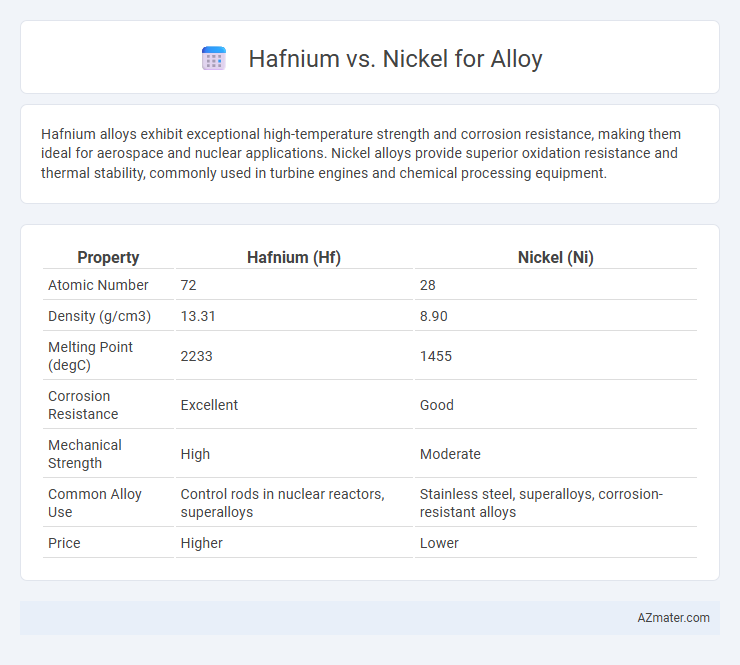Hafnium alloys exhibit exceptional high-temperature strength and corrosion resistance, making them ideal for aerospace and nuclear applications. Nickel alloys provide superior oxidation resistance and thermal stability, commonly used in turbine engines and chemical processing equipment.
Table of Comparison
| Property | Hafnium (Hf) | Nickel (Ni) |
|---|---|---|
| Atomic Number | 72 | 28 |
| Density (g/cm3) | 13.31 | 8.90 |
| Melting Point (degC) | 2233 | 1455 |
| Corrosion Resistance | Excellent | Good |
| Mechanical Strength | High | Moderate |
| Common Alloy Use | Control rods in nuclear reactors, superalloys | Stainless steel, superalloys, corrosion-resistant alloys |
| Price | Higher | Lower |
Overview of Hafnium and Nickel in Alloy Production
Hafnium is prized in alloy production for its high melting point, corrosion resistance, and ability to enhance mechanical strength, especially in aerospace and nuclear applications. Nickel alloys, known for exceptional toughness, resistance to oxidation, and thermal stability, are widely used in industrial processes and high-temperature environments. Combining hafnium with nickel in alloys improves durability, creep resistance, and overall performance under extreme conditions.
Key Properties of Hafnium in Alloys
Hafnium significantly enhances alloy performance due to its high melting point of 2233degC and excellent corrosion resistance, making it ideal for aerospace and nuclear applications. Its strong neutron absorption cross-section improves nuclear fuel cladding, while maintaining mechanical strength at elevated temperatures. In contrast, nickel offers good ductility and oxidation resistance but lacks hafnium's superior thermal stability and neutron absorption capabilities.
Key Properties of Nickel in Alloys
Nickel in alloys significantly enhances corrosion resistance, high-temperature strength, and toughness, making it a preferred choice for demanding applications such as aerospace and chemical processing. Its excellent oxidation resistance and ability to improve ductility contribute to the durability and lifespan of superalloys. Compared to hafnium, nickel provides superior structural stability and versatility in alloy compositions, facilitating improved mechanical performance under extreme conditions.
Applications of Hafnium-Alloyed Materials
Hafnium-alloyed materials exhibit superior high-temperature strength, corrosion resistance, and neutron absorption, making them ideal for aerospace components, nuclear reactor control rods, and superalloys used in jet engines. Compared to nickel alloys, hafnium enhances creep resistance and oxidation resistance at extreme temperatures, improving the durability of turbine blades and heat exchangers. These properties enable hafnium alloys to perform reliably in harsh environments where nickel alloys may degrade faster.
Applications of Nickel-Based Alloys
Nickel-based alloys are extensively used in aerospace, power generation, and chemical processing due to their exceptional corrosion resistance, high-temperature strength, and oxidation resistance. In contrast, hafnium is primarily added in small amounts to improve the high-temperature creep resistance and oxidation stability of superalloys rather than being a primary alloying element. Nickel's versatile performance in extreme environments makes it the preferred base metal for superalloys in turbine engines and nuclear reactors.
Hafnium vs Nickel: Corrosion Resistance Comparison
Hafnium exhibits superior corrosion resistance compared to nickel, particularly in high-temperature and aggressive chemical environments, due to its stable oxide film formation. While nickel alloys offer good general corrosion resistance, hafnium alloys excel in resisting oxidation, sulfidation, and molten metal attack, making them ideal for aerospace, nuclear reactors, and superalloy applications. The enhanced durability of hafnium under extreme conditions significantly outperforms nickel, providing longer service life in corrosive settings.
High-Temperature Performance: Hafnium vs Nickel Alloys
Hafnium alloys exhibit superior high-temperature performance compared to nickel alloys due to their exceptional melting point of approximately 2233degC and excellent oxidation resistance at elevated temperatures. Nickel alloys, while widely used in aerospace and power generation, typically have melting points around 1455degC and can suffer from creep and oxidation under extreme conditions. Hafnium's ability to maintain structural integrity and resist deformation at temperatures exceeding 1800degC makes it ideal for advanced turbine components and heat exchangers.
Cost Analysis: Hafnium vs Nickel for Alloying
Hafnium alloys are significantly more expensive than nickel alloys due to the rarity and complex extraction process of hafnium, with prices often exceeding $1,200 per kilogram compared to nickel's average of $20 per kilogram. Despite the high cost, hafnium offers superior corrosion resistance and high-temperature stability, which justifies its use in specialized aerospace and nuclear applications where performance outweighs material cost. Nickel alloys remain the preferred choice for cost-sensitive industries, offering robust strength and corrosion resistance at a fraction of the price, making them suitable for large-scale industrial alloy production.
Environmental and Sustainability Considerations
Hafnium alloys exhibit superior corrosion resistance and high-temperature stability, reducing the environmental impact through enhanced durability and longer material lifespan in aerospace and nuclear applications. Nickel, while widely used for its strength and corrosion resistance, often involves intensive mining processes that contribute to considerable carbon emissions and habitat disruption. Selecting hafnium over nickel in specialized alloys can support sustainability goals by minimizing resource extraction and improving alloy recyclability.
Choosing the Right Element for Advanced Alloy Design
Hafnium offers exceptional corrosion resistance and high-temperature stability, making it ideal for aerospace and nuclear alloys where durability under extreme conditions is critical. Nickel provides excellent strength, toughness, and oxidation resistance at elevated temperatures, commonly used in superalloys for turbine engines and chemical plants. Selecting between hafnium and nickel depends on the specific operational environment, mechanical requirements, and cost constraints associated with advanced alloy design.

Infographic: Hafnium vs Nickel for Alloy
 azmater.com
azmater.com